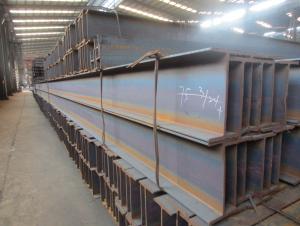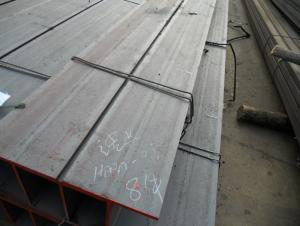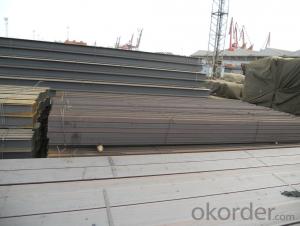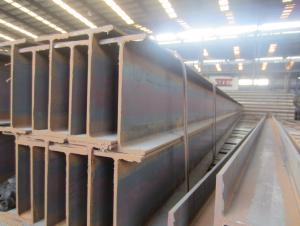JIS Standard Hot Rolled Steel H Beams of Material SS400
- Loading Port:
- Tianjin
- Payment Terms:
- TT OR LC
- Min Order Qty:
- 25 m.t.
- Supply Capability:
- 200000 m.t./month
OKorder Service Pledge
OKorder Financial Service
You Might Also Like
Specifications of JIS Standard Hot Rolled Steel H Beams of Material SS400
1. Standard: JIS G3101, SS400(1987),GB700-88, Q235B,EN10034-1993 / EN10025-2004,
HEA100-HEA500,HEB100-HEB500
2. Grade: Q235, SS400 or Equivalent
3. Length: 6m,10m, 12m as following table
4. Invoicing on theoretical weight or actual weight as customer request
5.Payment: TT or L/C
6. Sizes:
SIZE(mm) | DIMENSION(kg/m) |
100*100 | 16.9 |
125*125 | 23.6 |
150*75 | 14 |
150*150 | 31.1 |
148*100 | 20.7 |
198*99 | 17.8 |
200*100 | 20.9 |
248*124 | 25.1 |
250*125 | 29 |
300*150 | 36.7 |
298*149 | 32 |
200*200 | 49.9 |
294*200 | 55.8 |
346*174 | 41.2 |
350*175 | 49.4 |
244*175 | 43.6 |
175*175 | 40.4 |
294*200 | 55.8 |
298*201 | 64.4 |
346*174 | 41.2 |
350*175 | 49.4 |
400*200 | 65.4 |
396*199 | 56.1 |
450*200 | 74.9 |
446*199 | 65.1 |
340*250 | 78.1 |
500*200 | 88.1 |
300*150 | 36.7 |
Usage & Applications of JIS Standard Hot Rolled Steel H Beams of Material SS400
Commercial building structure ;Pre-engineered buildings; Machinery support structure; Prefabricated structure; Medium scale bridges; Ship-building structure. etc.
Packaging & Delivery of JIS Standard Hot Rolled Steel H Beams of Material SS400
1. Packing: it is nude packed in bundles by steel wire rod
2. Bundle weight: not more than 3.5MT for bulk vessel; less than 3 MT for container load
3. Marks:
Color marking: There will be color marking on both end of the bundle for the cargo delivered by bulk vessel. That makes it easily to distinguish at the destination port.
Tag mark: there will be tag mark tied up on the bundles. The information usually including supplier logo and name, product name, made in China, shipping marks and other information request by the customer.
If loading by container the marking is not needed, but we will prepare it as customer request.
4. Transportation: the goods are delivered by truck from mill to loading port, the maximum quantity can be loaded is around 40MTs by each truck. If the order quantity cannot reach the full truck loaded, the transportation cost per ton will be little higher than full load.
5. Delivered by container or bulk vessel
Production flow of JIS Standard Hot Rolled Steel H Beams of Material SS400
Material prepare (billet) —heat up—rough rolling—precision rolling—cooling—packing—storage and transportation

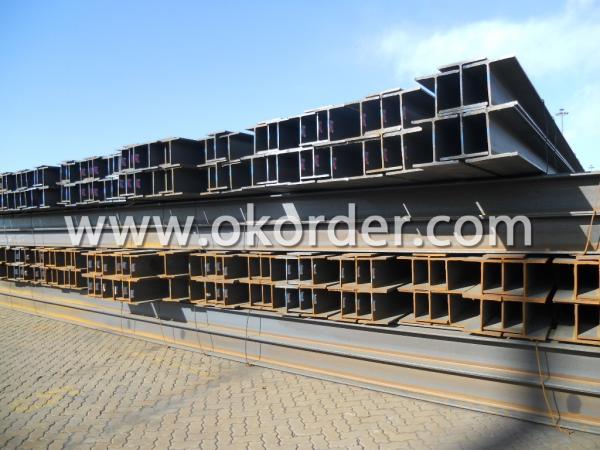
- Q:How do steel H-beams resist bending and deflection?
- Steel H-beams are designed to resist bending and deflection due to their unique shape and material properties. The H-shape of the beam provides a higher moment of inertia compared to other structural shapes, such as I-beams or channels. This means that the H-beam can withstand greater bending moments without significant deflection. The top and bottom flanges of the H-beam are wider and thicker than the web, which helps distribute the bending stress more evenly along the length of the beam. The flanges act as the main load-carrying elements, while the web connects and supports the flanges. The wider the flange, the greater the resistance to bending. Moreover, steel itself is a strong and rigid material with high tensile and compressive strength. This makes steel H-beams highly resistant to bending and deflection. When a load is applied to the beam, the top and bottom flanges work in compression and tension, respectively, to counteract the bending forces. The steel's strength allows it to efficiently resist these forces and maintain its shape. Furthermore, the depth of the H-beam plays a crucial role in its resistance to bending and deflection. A deeper beam has a larger moment of inertia, which increases its resistance to bending. This is because a higher moment of inertia means that more material is located farther from the neutral axis of the beam, resulting in a greater resistance to bending forces. In summary, steel H-beams resist bending and deflection through their unique H-shape, wide flanges, strong material properties, and depth. These factors allow H-beams to efficiently distribute and counteract bending moments, making them a popular choice in various structural applications.
- Q:Are steel H-beams suitable for convention halls?
- Yes, steel H-beams are commonly used in convention halls due to their strength, durability, and ability to support heavy loads. They provide structural stability and can be easily prefabricated and installed, making them a suitable choice for convention hall construction.
- Q:What's the difference between I-beam and H?
- The difference and application description of H steel and I-beamI-steel whether ordinary or light, because the section size are relatively high and narrow, so the moment of inertia of the main sections of the two sleeve is large, therefore, generally only can be directly used in the web plane bending member or the composition of lattice stress components. It is not suitable for the axial compression member or the bent member perpendicular to the web plane, which has great limitations in its application.
- Q:Can steel H-beams be used for pedestrian walkways?
- Yes, steel H-beams can be used for pedestrian walkways. Steel H-beams are commonly used in construction due to their strength and durability. They provide a sturdy support system that can withstand heavy loads and ensure the safety of pedestrians. Additionally, steel H-beams can be designed to meet specific requirements such as length, width, and height, making them versatile for various walkway designs. They are also resistant to weather conditions and require minimal maintenance, making them an ideal choice for pedestrian walkways in both indoor and outdoor settings.
- Q:Are steel H-beams resistant to seismic activity?
- Steel H-beams are generally known to be resistant to seismic activity. This is because steel is a highly durable and strong material, making it ideal for withstanding the forces generated during seismic events. H-beams are specifically designed to evenly distribute the load along their length, offering excellent structural support against vertical and lateral movements. Furthermore, steel H-beams are commonly used in earthquake-prone regions due to their superior ability to withstand seismic forces. The flexibility and elasticity of steel allow it to absorb and dissipate seismic energy, minimizing damage caused by ground shaking. Additionally, steel H-beams are often interconnected with other structural elements, such as columns and braces, forming a seismic-resistant system that effectively absorbs and redirects seismic forces. It is important to note, however, that the seismic resistance of steel H-beams can vary depending on factors such as design, construction quality, and adherence to building codes and regulations. To ensure that steel H-beams are appropriately designed and installed to withstand the specific seismic conditions of an area, proper engineering and construction practices must be followed. In conclusion, when designed and constructed properly, steel H-beams provide excellent resistance to seismic activity and are widely utilized in earthquake-resistant building structures.
- Q:Are steel H-beams cost-effective compared to other beam options?
- Yes, steel H-beams are generally considered to be cost-effective compared to other beam options. There are several factors that contribute to this cost-effectiveness. Firstly, steel H-beams offer a high strength-to-weight ratio, meaning they can support heavy loads while being relatively lightweight themselves. This can result in cost savings in terms of transportation and installation, as well as reduced foundation requirements. Additionally, steel H-beams are durable and have a long lifespan. They are resistant to corrosion, fire, and pests, which means they require minimal maintenance and replacement over time. This can result in significant cost savings in terms of ongoing maintenance and repairs. Furthermore, steel H-beams are readily available and easy to manufacture. This means they can be produced in large quantities at a relatively low cost, making them more affordable compared to other beam options. The availability of standardized sizes and shapes also contributes to their cost-effectiveness, as it simplifies the design and construction process. It is important to note that the cost-effectiveness of steel H-beams can vary depending on the specific project requirements and the local market conditions. However, in general, steel H-beams offer a combination of strength, durability, and affordability that makes them a cost-effective choice for many construction projects.
- Q:How do steel H-beams perform in high-temperature applications?
- Due to their high structural strength and load-bearing capacity, steel H-beams find wide application in construction and engineering projects. However, exposure to high temperatures can negatively impact the performance of these beams. When subjected to elevated temperatures, steel H-beams undergo thermal expansion, resulting in expansion and deformation. This expansion diminishes the structural stability and integrity of the beams, compromising their load-carrying capacity. Consequently, they become less suitable for use in high-temperature environments. Furthermore, prolonged exposure to high temperatures weakens the steel material itself. As the temperature rises, the strength and hardness of steel decrease, further affecting the performance of H-beams. They may lose their ability to support heavy loads and may even deform or buckle under extreme heat conditions. To mitigate the adverse effects of high temperatures, various measures can be employed. One commonly used approach is the application of fire-resistant coatings, such as intumescent paints, to shield the steel H-beams from direct heat exposure. These coatings create a barrier that slows down the transfer of heat to the steel, thereby preserving their structural integrity to some extent. Additionally, selecting the appropriate steel grade is crucial for ensuring the performance of H-beams in high-temperature applications. Certain steel types, such as low-alloy steels or heat-resistant steels, are specifically designed to withstand elevated temperatures without significant loss in strength and stability. These specialized steel grades can be utilized in the manufacture of H-beams that are better suited for high-temperature environments. In conclusion, while steel H-beams possess excellent structural properties under normal conditions, their performance is compromised in high-temperature applications. It is important to consider the potential effects of thermal expansion, structural stability, and material strength when utilizing steel H-beams in environments with elevated temperatures. Proper precautions, such as the use of fire-resistant coatings and the selection of suitable steel grades, should be taken to ensure the safe and reliable operation of H-beams in such conditions.
- Q:H steel and I-beam, which bearing good?
- The length of the I-beam is small and the height is big. It can only bear the force in one direction. H steel is deep in groove and big in thickness and can bear two directions of force.
- Q:How are steel H-beams different from other types of beams?
- Steel H-beams, also known as H-sections, are distinct from other types of beams due to their specific shape and structural properties. The main difference lies in their cross-sectional shape, which resembles the letter "H." This unique shape provides significant advantages over other beam types. Firstly, the H-beam's shape allows for a higher load-bearing capacity compared to other beams with similar weight. This is because the shape of the H-beam distributes the weight evenly along its length, maximizing its ability to withstand heavy loads. As a result, H-beams are widely used in construction projects that require strong and durable structural support, such as in the construction of high-rise buildings, bridges, and industrial facilities. Secondly, H-beams offer greater structural stability. The flanges, or top and bottom horizontal sections of the H-beam, provide resistance against bending and twisting forces. This characteristic makes H-beams more resistant to deformations and enables them to maintain their shape under heavy loads. Furthermore, the web, or vertical section of the H-beam, provides additional support and rigidity, ensuring the overall stability of the structure. Another key advantage of H-beams is their versatility. Due to their inherent strength and stability, H-beams can span longer distances without the need for intermediate supports. This allows for larger open spaces and more flexible architectural designs. Additionally, H-beams can be easily welded together to create longer beams, further expanding their application possibilities. Lastly, H-beams offer cost-effectiveness. Despite their robustness, H-beams are relatively lightweight compared to their load-bearing capacity. This reduces transportation costs and simplifies the installation process, making them a cost-effective choice for construction projects. In summary, steel H-beams differ from other types of beams due to their unique cross-sectional shape, which provides increased load-bearing capacity, structural stability, versatility, and cost-effectiveness. These characteristics make H-beams the preferred choice for various construction applications where strength, durability, and efficiency are crucial factors.
- Q:What are the factors to consider when selecting steel H-beams for a construction project?
- To ensure the success of a construction project, there are several crucial factors to consider when choosing steel H-beams. Firstly, the load-bearing capacity of the beams must be determined. This is achieved by considering their height, thickness, and the type of steel used. The primary purpose of H-beams is to provide structural support and bear heavy loads, so it is essential to assess the anticipated load requirements for the project. Secondly, the size and dimensions of the H-beams should be carefully selected. Various options are available, and the appropriate size must be chosen to adequately support the structure. The height, width, and thickness of the beams should be based on the design requirements and expected loads. The steel grade of the H-beams is another critical consideration. It directly affects their strength and durability. Different steel grades have varying mechanical properties, such as yield strength and tensile strength. Consulting with a structural engineer or steel supplier is advisable to determine the most suitable steel grade for the project. In addition to ensuring structural integrity, cost-effectiveness should also be taken into account. Comparing prices from different suppliers and considering factors like transportation costs and availability can help make an informed decision. Compatibility with other construction materials, such as concrete or wood, is also important. The selected H-beams should be compatible with these materials and easily integrated into the overall design and construction process. Furthermore, it is crucial to ensure that the chosen H-beams meet the required quality standards and are certified by relevant authorities. This guarantees that the beams have been manufactured using appropriate processes and adhere to industry standards. In conclusion, when selecting steel H-beams for a construction project, careful consideration of factors like load-bearing capacity, size and dimensions, steel grade, cost-effectiveness, compatibility with other materials, and quality and certification is necessary to ensure the project's structural integrity and success.
1. Manufacturer Overview |
|
|---|---|
| Location | |
| Year Established | |
| Annual Output Value | |
| Main Markets | |
| Company Certifications | |
2. Manufacturer Certificates |
|
|---|---|
| a) Certification Name | |
| Range | |
| Reference | |
| Validity Period | |
3. Manufacturer Capability |
|
|---|---|
| a)Trade Capacity | |
| Nearest Port | |
| Export Percentage | |
| No.of Employees in Trade Department | |
| Language Spoken: | |
| b)Factory Information | |
| Factory Size: | |
| No. of Production Lines | |
| Contract Manufacturing | |
| Product Price Range | |
Send your message to us
JIS Standard Hot Rolled Steel H Beams of Material SS400
- Loading Port:
- Tianjin
- Payment Terms:
- TT OR LC
- Min Order Qty:
- 25 m.t.
- Supply Capability:
- 200000 m.t./month
OKorder Service Pledge
OKorder Financial Service
Similar products
New products
Hot products
Related keywords
